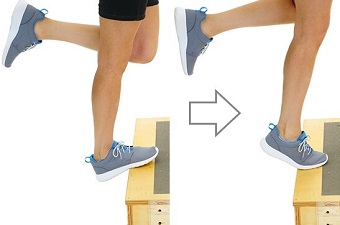- Home
- Common Foot Problems
- Sprained Ankle
- Treatment
Ankle Sprain Treatment
Written By: Chloe Wilson BSc(Hons) Physiotherapy
Reviewed By: FPE Medical Review Board
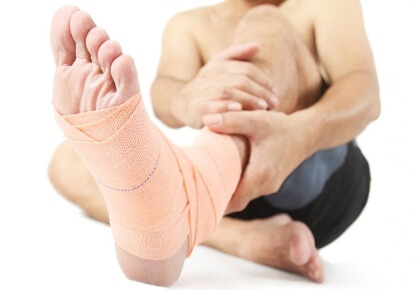
Ankle sprain treatment is vital to prevent ongoing problems of pain and instability after an ankle ligament injury.
Ankle sprains are common and approximately 35% of people who sustain them will have recurrent problems in the future, making effective rehab vital.
A sprain is where one of the ligaments around the ankle is overstretched, often resulting in damage and tearing of the fibres. They usually result in pain, swelling and bruising around the foot and in severe cases there may be difficulty walking and instability.
There are three grades of ankle sprain:
- Grade 1 Ankle Sprain: minor damage
- Grade 2 Ankle Sprain: moderate damage
- Grade 3 Ankle Sprain: complete rupture
The severity of the ankle sprain will determine the best course of treatment and the recovery process.
Here, we will look at the
different ankle sprain treatment options for the different grades of injury as well as how to prevent long term problems
and re-injury. If you want to know more about the causes, diagnosis and symptoms of this type of injury, visit the ankle sprain overview.
General Ankle Sprain Treatment
The following ideas for ankle sprain treatment are suitable for all grades of sprain.
1. PRICE
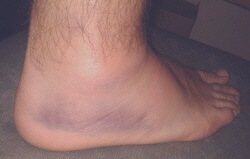
The best ankle sprain treatment to start with is PRICE: Protect, Rest, Ice, Compression and Elevation. This aims to reduce the bleeding, swelling and pain around the injured ligament which helps to speed up healing.
Protect
Sprained ankle first aid starts with protecting the ankle from further injury. It may be a bandage or support around the ankle or in severe cases, a plaster cast may be applied to limit all ankle movement.
Rest
After an ankle sprain you should avoid activities that aggravate your symptoms, but don’t rest completely – the key is relative rest. You can still do exercises to keep other body parts strong.
It is generally fine to walk immediately after spraining your ankle but will probably be uncomfortable. You may need to use crutches initially to help you walk if you are having difficulty taking weight through your foot. As the ligament heals, you will gradually be able to take more weight through your foot.
Ice
Applying ice regularly is a vital part of ankle sprain treatment. Ice is particularly effective in the early stages after an ankle sprain, but only if used appropriately. It should be applied every couple of hours for around 10-15 minutes.
Find out how to safely and effectively use ice as part of your ankle sprain treatment in the Cold Therapy section.
Compression
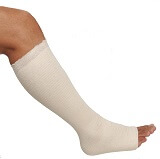
A compression bandage such as tubigrip helps to reduce swelling and provides minimal support. It should be worn double thickness from just below your knee down to your toes. Tubigrip should not be worn at night.
Tubigrip compression bandage is generally safer and more effective than a normal bandage for ankle sprain treatment. You can find out more about Tubigrip on our sister site.
Elevation
Swelling is a common problem with ankle sprains and is one of the reasons the ankle stays painful and stiff for so long. Keeping the foot elevated higher than the level of your heart when resting will help to reduce swelling.
Swelling tends to pool around the ankle due to gravity, so keeping the foot elevated can really make a difference as it drains excess fluid away. You can find out about other ways to reduce swelling in the swollen foot treatment section.
2. Ankle Exercises
Exercises are a really important part of ankle sprain treatment. They help mobilise the ankle joint and work the muscles help to prevent stiffness and weakness. Movement also helps to speed up the healing process after an ankle sprain by improving circulation.
As well as doing a range of movement exercises and strengthening exercises, balance and proprioception exercises are really important to regain stability around your ankle as part of your ankle sprain treatment. The level and type of exercises will depend on the severity of your injury. Visit the foot and ankle exercises section to find the best exercises for you.
3. Medication
Non-steroidal anti-inflammatories (NSAIDs) such as ibuprofen and naproxen can be used to help reduce pain and inflammation, but always talk to your doctor before taking them as they can have side effects.
Grade 2 & 3 Ankle Sprain Treatment
With severe ankle sprains, more input is likely to be required to ensure a full recovery.
1. Physiotherapy
Effective physiotherapy is a vital part of ankle sprain treatment with severe sprains. As well as an exercise programme, your physiotherapist may also do some manual therapy to reduce any stiffness in the joints of the foot.
Stiffness around the talus bone is a common problem associated with ankle sprains, as is dislocation of the small foot bones, known as cuboid syndrome, often leading to long term problems, so manual therapy should be done to restore the normal gliding movements of the bones.
Deep transverse friction massage can help reduce the build-up of scar tissue. You may also be given ultrasound to help reduce inflammation and promote healing, although the evidence behind ultrasound is somewhat lacking.
2. Ankle Brace/Support
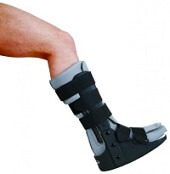
If there is instability around the ankle, you may need to wear a brace or ankle support as part of your ankle sprain treatment to prevent further injury.
In severe cases, you may be given a cast or walking boot to immobilise the joint temporarily while the ligament heals
3. Footwear
It can help to wear high-top shoes such as walking boots for extra support after an ankle sprain. They should be tight but should not cause discomfort. Avoid high heels to reduce the risk of re-injury.
4. Surgery
Surgery is not a common ankle sprain treatment, but in some cases of severe ankle sprains, it may be necessary to repair the torn ligament surgically. If rehab has failed to resolve persistent instability, surgery will also be considered.
Most sprains will respond well to these ankle sprain treatment methods, but if they are not done properly, or if rehab stops too soon, long term problems can ensue such as cuboid syndrome which causes ongoing lateral foot pain.
You should not return to sports until you can hop on your injured foot without any problems.
How Long Should It Take For A Sprained Ankle To Heal?
Recovery time after an ankle sprain will depend on the grade of injury:
- Grade 1 Ankle Sprains: where just a few ligament fibres have been damaged, will usually settle down in 2-6 weeks with simple home treatment
- Grade 2 Ankle Sprains: Usually take 4-6 weeks for the pain and swelling to settle but it may take up to 3 months to fully rehab and regain full strength, stability and control at the ankle
- Grade 3 Ankle Sprains: Can take 3-6 months to fully recover from.
Preventing Ankle Sprains
It goes without saying, prevention is better than cure. With more severe ankle sprains, it is really important to fully rehab to prevent long term problems. The recurrence rates for lateral ligaments sprains have been reported to be as high as 80%. This is most commonly due to persistent weakness around the ankle, stiffness in the joint and reduced proprioception.
Ankle sprain treatment needs to be carried out effectively and completely to avoid these and prevent recurrence. Here are some things you can do to help reduce your risk of further problems.
1. Appropriate Footwear
Wear appropriate footwear for the activity you are doing. Shoes/boots should provide sufficient support without being too tight. Be aware that you are at increased risk of a rolled ankle if you wear high heels.
2. Balance/ Proprioception Exercises
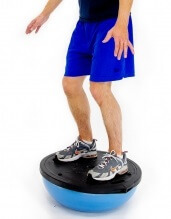
Your ankle plays a vital role in proprioception, the body’s awareness of body position. It helps make rapid adjustments to your position without you even thinking about it, reducing your risk of injury.
A good quick test is to see if you can stand on one leg with your eyes closed for one minute. If you can’t, you need to do balance challenging exercises.
3. Take Care On Uneven Surfaces
You are much more likely to sprain your ankle on uneven surfaces, so take extra care. Watch where you are putting your feet, especially on mountains, fields, snow, building sites and even pavements and go slowly.
4. Warm Up
Get your body ready for action and warm up properly before doing exercise.
5. Braces/Taping
Wearing an ankle brace or taping the ankle can help provide stability and reduce the risk of injury. Taping should only be carried out by a trained professional.
What Else Can Help?
To find out more about ankle sprains and their causes and symptoms, visit the ankle sprain overview.
If this is not sounding quite like your pain, visit the foot pain diagnosis section for help working out what is wrong.
Related Articles
Page Last Updated: 10/11/22
Next Review Due: 10/11/23
